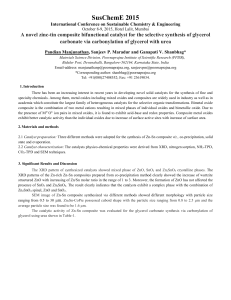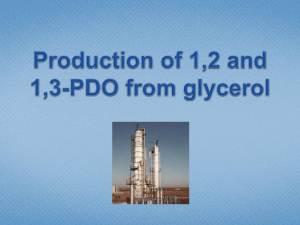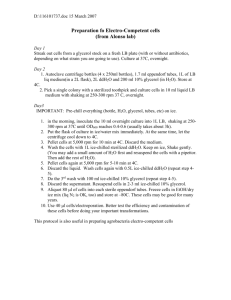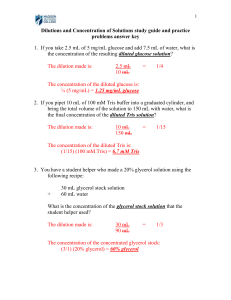300715101753Abstract-paramesh
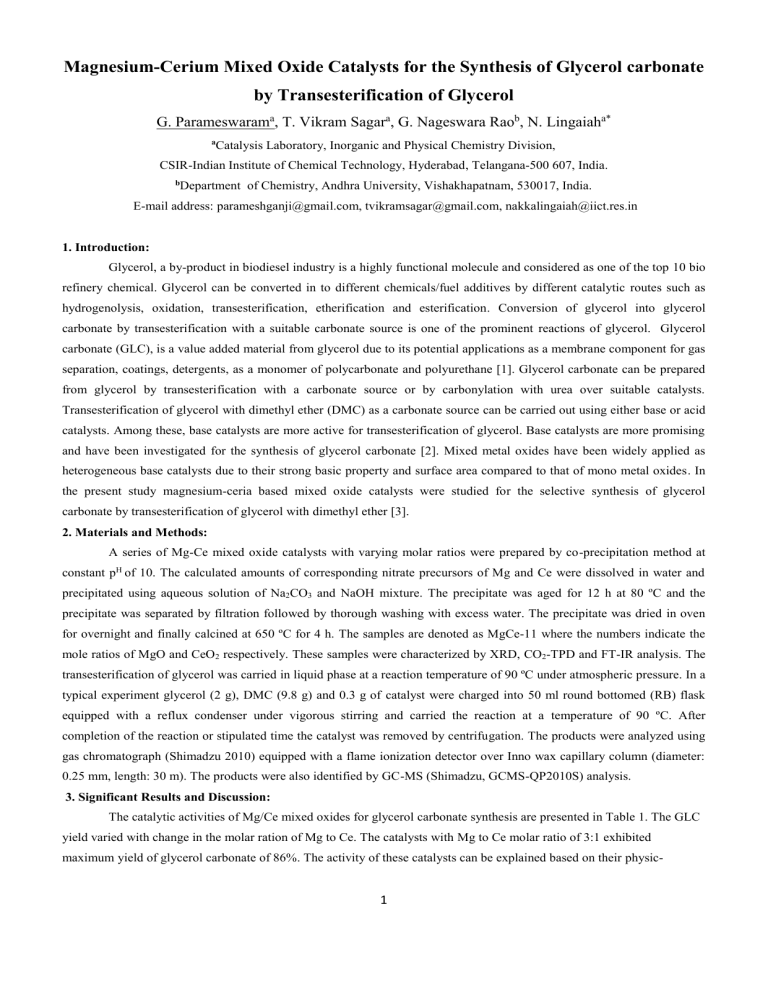
Magnesium-Cerium Mixed Oxide Catalysts for the Synthesis of Glycerol carbonate by Transesterification of Glycerol
G. Parameswaram
a
, T. Vikram Sagar
a
, G. Nageswara Rao
b
, N. Lingaiah
a* a Catalysis Laboratory, Inorganic and Physical Chemistry Division,
CSIR-Indian Institute of Chemical Technology, Hyderabad, Telangana-500 607, India. b Department of Chemistry, Andhra University, Vishakhapatnam, 530017, India.
E-mail address: parameshganji@gmail.com, tvikramsagar@gmail.com, nakkalingaiah@iict.res.in
1. Introduction:
Glycerol, a by-product in biodiesel industry is a highly functional molecule and considered as one of the top 10 bio refinery chemical. Glycerol can be converted in to different chemicals/fuel additives by different catalytic routes such as hydrogenolysis, oxidation, transesterification, etherification and esterification. Conversion of glycerol into glycerol carbonate by transesterification with a suitable carbonate source is one of the prominent reactions of glycerol. Glycerol carbonate (GLC), is a value added material from glycerol due to its potential applications as a membrane component for gas separation, coatings, detergents, as a monomer of polycarbonate and polyurethane [1]. Glycerol carbonate can be prepared from glycerol by transesterification with a carbonate source or by carbonylation with urea over suitable catalysts.
Transesterification of glycerol with dimethyl ether (DMC) as a carbonate source can be carried out using either base or acid catalysts. Among these, base catalysts are more active for transesterification of glycerol. Base catalysts are more promising and have been investigated for the synthesis of glycerol carbonate [2]. Mixed metal oxides have been widely applied as heterogeneous base catalysts due to their strong basic property and surface area compared to that of mono metal oxides. In the present study magnesium-ceria based mixed oxide catalysts were studied for the selective synthesis of glycerol carbonate by transesterification of glycerol with dimethyl ether [3].
2. Materials and Methods:
A series of Mg-Ce mixed oxide catalysts with varying molar ratios were prepared by co-precipitation method at constant p H of 10. The calculated amounts of corresponding nitrate precursors of Mg and Ce were dissolved in water and precipitated using aqueous solution of Na
2
CO
3
and NaOH mixture. The precipitate was aged for 12 h at 80 ºC and the precipitate was separated by filtration followed by thorough washing with excess water. The precipitate was dried in oven for overnight and finally calcined at 650 ºC for 4 h. The samples are denoted as MgCe-11 where the numbers indicate the mole ratios of MgO and CeO
2
respectively. These samples were characterized by XRD, CO
2
-TPD and FT-IR analysis. The transesterification of glycerol was carried in liquid phase at a reaction temperature of 90 ºC under atmospheric pressure. In a typical experiment glycerol (2 g), DMC (9.8 g) and 0.3 g of catalyst were charged into 50 ml round bottomed (RB) flask equipped with a reflux condenser under vigorous stirring and carried the reaction at a temperature of 90 ºC. After completion of the reaction or stipulated time the catalyst was removed by centrifugation. The products were analyzed using gas chromatograph (Shimadzu 2010) equipped with a flame ionization detector over Inno wax capillary column (diameter:
0.25 mm, length: 30 m). The products were also identified by GC-MS (Shimadzu, GCMS-QP2010S) analysis.
3. Significant Results and Discussion:
The catalytic activities of Mg/Ce mixed oxides for glycerol carbonate synthesis are presented in Table 1. The GLC yield varied with change in the molar ration of Mg to Ce. The catalysts with Mg to Ce molar ratio of 3:1 exhibited maximum yield of glycerol carbonate of 86%. The activity of these catalysts can be explained based on their physic-
1
chemical characteristics. The basicity of the catalysts was estimated by TPD of CO
2
and the corresponding TPD profiles are shown in Figure 1. These catalysts exhibited a strong desorption peak in the temperature range of 400 to 550 °C.
Table 1: Screening of the catalysts for the transesterification of glycerol
Catalyst MgO to CeO
2
ratio GLC yield (%) TON
MgCe-11 1:1 56 8.61
MgCe-21 2:1 71 13.3
MgCe-31 3:1 86 17.6
The intensity of desorption peak is increased with increase in Mg to Ce ratio. The catalysts with Mg to Ce ratio of 3:1 showed an intense peak related strong basic sites. The high activity of Mg-Ce with 3:1 ratio is directly related to its high amount of strong basic sites. The most active Mg-Ce catalyst was further studied to optimize the reaction conditions.
Figure 1: TPD of CO
2
patterns (a) MgCe-11 (b) MgCe-21 and (c) MgCe-31
4. Conclusions:
In summary, Mg/Ce mixed oxides are efficient catalysts for the synthesis of glycerol carbonate by transesterification of glycerol with dimethyl carbonate. These magnesia based oxide catalysts activity was depended on the mole ratio of Mg and Ce and the catalyst with Mg to Ce mole ratio of 3:1 showed maximum activity due to the presence of strong basic sites. The influences of reaction parameters such as reaction time, temperature, molar ratio of glycerol to DMC and catalyst amount were also studied.
Acknowledgements
The authors thank Council of Scientific and Industrial Research (CSIR), New Delhi for the financial support in the form of
Indus Magic (CSC-0123) project under 12th Five Year Programme.
References:
[1] C.H.C. Zhou, J.N. Beltramini, Y.X. Fan, G.Q. Lu, Chem. Soc. Rev. 37(2008)527.
[2] J. R. Ochoa-Gez, O. Gez-Jiménez-Aberasturi, C. Ramírez-López, B. Maestro- Madurga,Green Chem .
14 (2012)3368.
[3] G. Parameswaram, M. Srinivas, B. Hari Babu, P.S. Sai Prasad, N. Lingaiah, Catal Sci Technol. 3 (2013) 3242.
2

